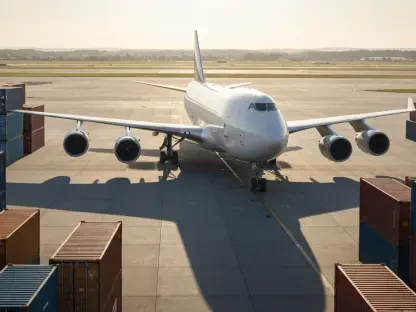Navigating customs regulations has long been a daunting challenge for global businesses, particularly those in the automotive industry. The complexity of compliance and the intricate rules often lead to logistical bottlenecks and additional costs. However, the growing trend towards digitization in customs management promises to streamline these processes and boost efficiency.
The Necessity of Adaptation
Global businesses are increasingly recognizing the necessity to adapt to stringent rules of origin regulations, especially those imposed by the European Union (EU). These regulations mandate that a certain percentage of a product must originate from the partner country or the EU to qualify for preferential tariffs or free trade agreements. Non-compliance with these stringent rules can lead to significant delays and extra costs at borders, underscoring the importance of accurate adherence to these regulations. Companies must ensure that their supply chain materials and production processes are well-documented to meet these complex requirements.
The Stringent Rules of Origin
For years, the intricate details of rules of origin regulations have created significant challenges for businesses. Products failing to meet the required percentage of local or regional content face the prospect of higher tariffs, nullifying the benefits of free trade agreements. This situation necessitates meticulous tracking of the origin of every component that makes up the final product. The exacting standards add layers of complexity to the already burdensome process of customs compliance, leading to potential roadblocks in logistics and additional handling costs. Failing to accurately implement these regulations not only affects the financial bottom line but also disrupts the smooth transit of goods across borders.
The Historical Dependence on Third-party Providers
Historically, many global businesses have relied heavily on third-party customs service providers to navigate these bureaucratic complexities. According to a survey conducted by Deloitte and AEB in 2020, around 75% of companies engaged customs service providers as intermediaries. The primary drivers for this reliance included a lack of in-house resources and expertise, along with a desire to enhance efficiency. By outsourcing these functions, companies hoped to mitigate the risks and avoid the intricacies of dealing directly with customs authorities. However, this approach is now witnessing a shift as digital solutions become more prevalent, enabling companies to bring customs management in-house.
Moving Towards Digital Transformation
The shift towards digital transformation in customs management signifies a major evolution in how businesses approach regulatory compliance. By leveraging advanced technologies, companies can now automate many of the manual processes traditionally handled by third-party providers, thus achieving greater accuracy and efficiency.
Case Study: A Global Manufacturer’s Shift
One prominent example of this digital shift can be seen in the case of a global manufacturer of trucks, buses, and construction equipment that faced substantial challenges in enhancing connectivity with customs authorities. This manufacturer, operating across Sweden, Belgium, and Mexico, sought to improve their compliance and logistics processes through the strategic integration of Oracle Transportation Management (OTM) software with the Oracle Global Trade Management (GTM) system. To implement this, they collaborated with the system integrator Accelalpha. This project aimed to link compliance and logistics systems by integrating Oracle GTM with OTM, develop standardized global interfaces for smoother communication with customs, and implement Accelalpha’s Customs Filing Audit solution.
Benefits of Integrated Systems
The integration of Oracle GTM with OTM proved to be highly beneficial, significantly streamlining the processes involved. This digital shift enabled the company to replace their outdated legacy systems and manual processes with a more efficient, automated setup. The benefits included improved customs declaration accuracy and optimized broker performance. Oracle GTM provided a centralized control point for multiple functions. This comprehensive solution allowed better oversight of trade compliance, customs filing, and document tracking, ultimately resulting in improved operational efficiency and enhanced financial visibility across the supply chain. This digital transformation has not only optimized customs procedures but also allowed the company to qualify shipments for free trade agreements more effectively.
Enhanced Efficiency and Compliance
By automating and enhancing customs procedures, businesses can achieve a higher level of efficiency and compliance in their operations. The implementation of advanced trade management systems dramatically changes how companies handle their import and export processes.
The Impact on Customs Procedures
For the manufacturer mentioned earlier, the adoption of Oracle GTM significantly reduced the time required to clear customs for Swedish imports by automating customs declarations. Integration with Descartes Systems Group’s Global Logistics Network (GLN) enabled standardized data transformation for customs and third parties, thus connecting all relevant stakeholders, including carriers, shippers, government authorities, and third-party logistics firms in Belgium, Sweden, and Mexico. This comprehensive, interconnected approach facilitated smoother and faster processing of goods across borders, drastically minimizing delays and reducing associated costs.
Financial and Operational Insights
Digital solutions provide invaluable financial and operational insights that are essential for modern businesses. For instance, the manufacturer reaped the benefits of deeper visibility into the various cost components involved in their supply chain. This included a more nuanced understanding of transportation and handling fees, insurance, duties, and taxes. Moreover, by analyzing bills of materials, the company could better qualify shipments for free trade agreements on a global scale, thus optimizing their customs strategies. Such insights are key to making informed decisions and ensuring ongoing compliance with international trade regulations.
Reducing Risks and Enhancing Compliance
One of the paramount advantages of digitization in customs management is its potential to mitigate risks and enhance compliance. By standardizing documentation and employing advanced screening technologies, businesses can significantly reduce their exposure to legal and financial penalties.
Standardization and Risk Minimization
A notable element of the Oracle GTM implementation was the creation of an Oracle GTM Trade Packet integration, which standardized the manufacturer’s filing formats. This ensured consistency and reliability in compliance documentation, crucial factors for minimizing risks associated with non-compliance, sanctions, and embargos. The adoption of such standardized systems allows for more seamless cross-border operations, thereby enhancing overall operational fluidity. In essence, standardized digital solutions reduce the likelihood of human error and ensure that all regulatory requirements are met consistently.
Screening Transactions
Another critical feature of Oracle GTM is its capability to screen business transactions against restricted parties and sanctioned entities. This proactive measure plays a crucial role in reducing the risks of fines and penalties that can be levied for unintentional violations of trade restrictions. By automating the screening process, the manufacturer bolstered its ability to operate compliantly across different jurisdictions. This integration ensures that every transaction adheres to international regulations, further fortifying the company’s compliance framework and shielding it from potential legal repercussions.
The Broad Impact of Technological Advancements
The broader implications of technological advancements in customs and trade management extend beyond individual companies, promising significant transformations across entire industries. The adoption of sophisticated digital solutions can alleviate many of the traditional pain points associated with international trade.
Transforming Traditional Practices
The introduction of digital solutions in customs and trade management is transforming traditional practices that have long been plagued by inefficiencies and complexities. As businesses adopt these advanced technologies, they can better navigate the myriad of logistical challenges posed by global trade. This transformation enables more efficient and effective handling of compliance requirements, reducing the time and resources needed for regulatory adherence. Such advancements empower businesses to focus on their core operations, boosting overall productivity and competitiveness in the market.
The Shift to In-house Solutions
Navigating customs regulations has consistently posed significant challenges for global businesses, especially within the automotive sector. The maze of compliance requirements, coupled with complex rules and regulations, often results in logistical delays and added expenses. Such hurdles can hinder the smooth operation of supply chains, thereby affecting overall productivity and profitability. However, there’s a promising shift underway, thanks to the increasing trend towards digitization in customs management. This digital revolution aims to streamline these cumbersome processes, minimizing bottlenecks and reducing costs. By adopting advanced digital tools and platforms, companies can now automate many aspects of customs compliance, leading to quicker, more efficient handling of administrative tasks. This not only helps in reducing errors but also speeds up the clearance process, allowing goods to move across borders with less friction. As a result, businesses can optimize their logistics operations, enhance supply chain efficiency, and ultimately boost their competitiveness and profitability in the global market.









